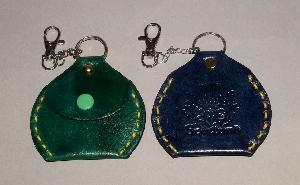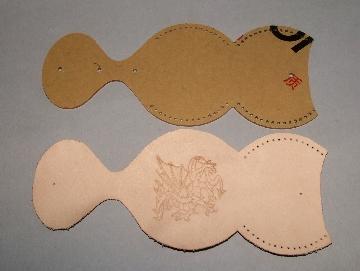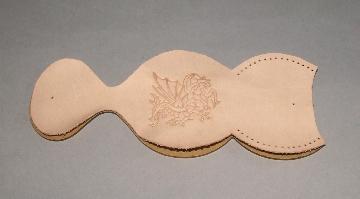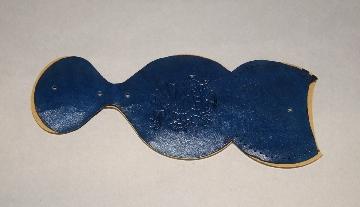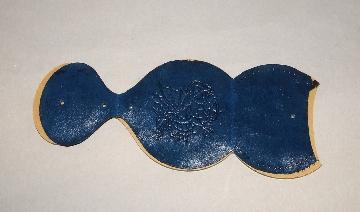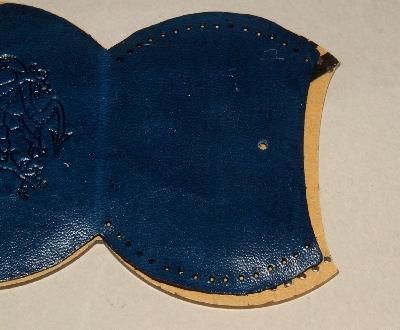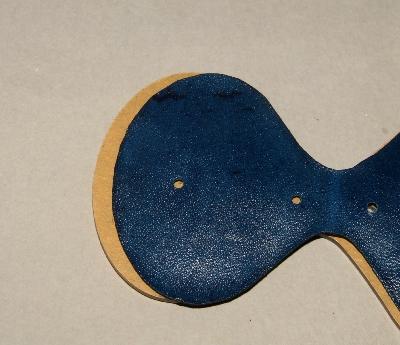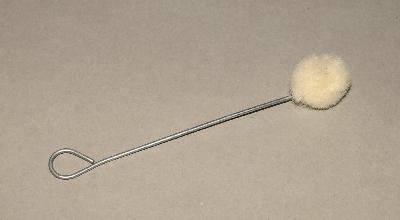-
Posts
5,923 -
Joined
Content Type
Profiles
Forums
Events
Blogs
Gallery
Everything posted by fredk
-
I use these; 2 teeth and 4 teeth. Stuck with 2mm teeth and 2mm spacing I have another set with larger teeth but they are only for lacing These certainly speed up making sewing holes, and of course no noise. I've also used them on busses and trains on long journeys
-
Tandy used to sell a 'Lace Maker; which if set up with multiple blades would cut a fringe. I bought a 'Lace Maker' in one of their sales, afair it cost me about £25. With care and attention it is possible to cut lengths of fringe wider than the tool. If you need a lot of fringe buying one of these might be an option. Before I got this I bought a few pre-cut lengths of fringe from a UK ebay seller. I can't remember the price but it was really cheap, like about £5 for 18 inches Closest I can get
-
May I come in? 1. My #1 son puts a business card and a card with a similar message to Pastor Bob's in with every order he sends out (Note to me; I must get some printed up) 2. May I say of a few things NOT to put in. These are the sort of things I get in packets a. packets of sweets/confectionary. One time I even got a scone in a parcel b. adverts for other businesses not directly linked to the sender, eg I get adverts for; cases of wine delivered at a special price, or for replacement PVC windows, or to re-mortgage my house c. novelty gifts not linked to the item sent, I don't mean leather keyrings and such, but other things. I recently got from a plastic model supplier a really ugly Chinese demon head with a long fringe for hanging up - WHY? or the whoopee cushion I got from a hardware supplier (double WHY?), or the small LED light torch in the shape of a van sent by a moulding resin supplier 3. Some things that others have sent me include; 1. a nice 'thank you' card and sometimes on that card or another an offer of X% off my next order using a code on the card. Even though I rarely take up the offer it is welcome should I want to. 2. A detailed card with instructions on either the item or how to contact the seller. eg, This morning I received a 20cm cube display box. It is 6 panels to slot together. I know how to do it but the seller included a slip of paper with detailed instructions for assembly which others might really need On #3; I used sell sets of 'Linka' walls to build little houses & buildings for model railway layouts. I always included an exploded diagram of construction and also a sheet of tips on how to construct the building I recently (as in a few years ago) sold a few desk top pen pots, from a Tandy pattern. I sold them flat but with instructions on how to fold it up to make the pot Always assume the customer is the most stupidist person on earth that you have ever met
-

Where to Let a Belt Dry
fredk replied to Gosut's topic in Dyes, Antiques, Stains, Glues, Waxes, Finishes and Conditioners.
I hang the belt up by the buckle. I have a rod affixed to a shelf unit. it sticks out by about 10 inches. I hang anything that can be hunged on it -
I would think you'd need to get one of those clicker cutters made to this, if you have a lot to do Otherwise, a template and a small oval hole punch and do each hole
-
I ordered twice from different sellers a 3D scanner unit. Neither arrived. Both scanners were coming out of China. One via Amazon, got money back. One via ebay, also got money back. This seller was arguing that the scanner was delivered to me. It was delivered to an address in Alberta, Canada. Now that seller is wanting me to pay for it again as 'it was delivered' ! 98% of the time all my deals work out fine PS. for biggish payments use a credit card. If the deal breaks down you can do a 'charge back' via the credit card. They'll give you your money back whilst they look at it. I'm not sure what the payment level is at but it used to as low as £50 / $50 Anyhoo, back on topic; I think you/we/me will have to start looking at 3D printed gun shapes
-
a. It looks nice b. it certainly almost matches the published book cover
-
That looks like a 'hammered' enamel finish A paint company called Hammerite has that colour in its range. I've used it An alternative is to take it to an independent automotive supplier store and see if they can mix you that colour of paint. Some places will mix it for you and supply in spray cans. But you'll get the colour but not the 'hammered' look https://www.hammerite.co.uk/location/exterior/?colorgroup=gold&surface=metal-garden-furniture&task=paint I think Hammerite call that colour Gold
-
Maybe for exercising? I used to know a chap who wore a chainmaille coat and lead weights wrapped around his wrists and ankles and went jogging and exercising. He was a long distance runner any hooo, you can get strips and rolls of lead in an aquarium shop, and as suggested, sandwich between two layers of leather
-

Quick sheath for a buddy
fredk replied to Garyak's topic in Gun Holsters, Rifle Slings and Knife Sheathes
That is most stupendously very excellent, very much so cos it was done in only 5 hours Your buddy better appreciate it and you and bring you back somat really nice and special from his trip -
I've mentioned before about leather shrinking whilst making projects and I think some people didn't believe me In this, all leather was cut from the same hide and the examples are actually from places close to each other I've been making 60 of these key-ring coin purses; I use an acrylic template (at top in picture) to draw around then I cut out the shape. The surface of the leather is dampened then a design stamp is pressed into the leather, (at bottom of the photo) The cut and stamped piece on top of the template, matches up ok, its the angle the photo was taken makes it look like they don't align Now here are two cut pieces, stamped then dyed with blue oil based dye Can you see the difference? I've aligned each piece on the centre . Both pieces are now shorter than the template and slightly narrower Close ups of each end; These examples are amongst the most extreme but other pieces are also shorter. It doesn't matter if I use oil or acrylic dye, the leather shrinks in both length and width. So what about thickness? The hide, in the area where these pieces were cut from measures 1.05mm thick After stamping but before dyeing the thickness is 0.89mm and the blue pieces, and others, after stamping, dyeing and sealing are 0.75mm thick A shrinkage of 0.3mm in thickness It doesn't sound very much but if you are (or I am) making a case where a good fit is essential it may make the difference Many years ago when I made certain types of cases I made them to be a very exact fit and could never figure out why that after stamping and dying the cases were too small. I thought I'd made some errors and often I made those cases two or three times over, the last being made over size. Then I realized that the leather was shrinking. I now take the shrinkage into consideration and sometimes rely on it happening in projects Not all leathers shrink by noticeable amounts, some by more than others. I made someone a waist belt using top dollar leather. By the time I'd finished the belt leather had shrunk by almost 3/4 inch over a 42 inch length - but I was allowing for some shrinkage, so all was good So I'd suggest if you are making a case or something which has a critical or exact size check your leather to see how much it will shrink HTH
-

Discoloration
fredk replied to optimusprimestamp's topic in Dyes, Antiques, Stains, Glues, Waxes, Finishes and Conditioners.
??? Please explain -
15 1/2 year old topic. I doubt if you'd be able to find these letter stamps now. Tandy, and Ivan put out letter stamps for a short while, like a short-run, then discontinue them pretty fast
-

Applying Vaseline/Lanolin to the flesh side of leather
fredk replied to simo289's topic in How Do I Do That?
Depending on the era and the need ancient maps were drawn on vellum, parchment or paper using graphite or waterproof ink If yours is to be a fantasy map, will it be like a basic treasure seeking map? An idea; rather than cut into the leather, cut very thin leather (about 0.5mm or less) and apply that to the surface of your thin leather base. Long thin strips for roads and rivers, shapes for lakes or forests, AAA shapes for mountains, all coloured/dyed appropriate colours, Shouldn't take any longer to glue the parts on than it would cutting and tooling it -
What defines 'redneck' and what defines 'English Gent' ? I'm pretty bad at dropping people or cultures in to definitions that are sort-of not very definitive I'm not being silly, just stoopid I mean 'viking', 'eskimo', 'native American' I can get but some others ?? Its the same with music - what goes into what style? I dunno with most
-

iso knight surcoat pattern/template
fredk replied to stampingdelight's topic in Patterns and Templates
or you could look for 'Simplicity' or 'McCalls' sewing pattern packs -
I have several pipes, but not a meerschaum, and I keep my baccy in an air-tight glass jar
-
I really hate wearing ball caps but that one is sooooo good. It just looks the right one for a-goin huntin in
-
tbh, the best thing for this is to assemble it and use it for a smaller reel and start again with larger pieces or a bodge; (just an idea) this may or may not work; cut a strip of thin leather, about 20mm wide and as long as the gusset plus about 12mm. Sew this thin piece to the gusset, about 6mm onto the gusset, then sew the thin piece to the front panel, about 6mm onto the panel. This should give you an extra 8mm along the join. Sew the thin leather on to the outside of gusset and front panel, thus making it a feature rather than a bodge
-
Which are 'x' and 'z' directions?
-
I have 20 unused Fiebings dye daubers surplus to needs Free, inc p&p (aka s&h) to anyone in the UK These are the ones you used to get free with every 4oz bottle of Fiebings dye PM me if you want them
-
In Europe Ikea sells something similar. 2 for £1.50
-
Please be aware there are three types of good PVA glue 1. Indoor use / normal grade. With this as soon as an item gets even slightly damp the glue reverts back to being liquid 2. Weather proof. With this the item needs a good wetting before it reverts back to be liquid 3. Outdoor or Marine use. This will not normally revert back to being liquid at any time due to application or immersion in water afair, all three of these PVA adhesives will release upon application of direct heat on the item, eg by use of a clothes iron on it, or sometimes by placing it in front of a heat source such as a hot gun or space heater
-
ummm, beeswax is honey. Bees consume honey and extrude it as tiny wax platelets which other bees press together to make larger sections of wax. For every 1 pound of wax bees have to consume between approximately 5 and 7 pounds of honey. I used to have a recipe for boiling and reducing down fish heads and bones to make a (very smelly) glue. Used to make it and use it in wood working



